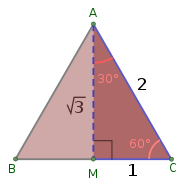|
Square root of 3
The square root of 3 is the positive real number that, when multiplied by itself, gives the number 3. It is denoted mathematically as or . It is more precisely called the principal square root of 3 to distinguish it from the negative number with the same property. The square root of 3 is an irrational number. It is also known as Theodorus' constant, after Theodorus of Cyrene, who proved its irrationality.[citation needed] In 2013, its numerical value in decimal notation was computed to ten billion digits.[1] Its decimal expansion, written here to 65 decimal places, is given by OEIS: A002194:
The fraction (1.732142857...) can be used as a good approximation. Despite having a denominator of only 56, it differs from the correct value by less than (approximately , with a relative error of ). The rounded value of 1.732 is correct to within 0.01% of the actual value.[citation needed] The fraction (1.73205080756...) is accurate to .[citation needed] Archimedes reported a range for its value: .[2] The lower limit is an accurate approximation for to (six decimal places, relative error ) and the upper limit to (four decimal places, relative error ). ExpressionsIt can be expressed as the simple continued fraction [1; 1, 2, 1, 2, 1, 2, 1, …] (sequence A040001 in the OEIS). So it is true to say: then when : Geometry and trigonometryThe height of an equilateral triangle with edge length 2 is √3. Also, the long leg of a 30-60-90 triangle with hypotenuse 2. And, the height of a regular hexagon with sides of length 1.    The square root of 3 can be found as the leg length of an equilateral triangle that encompasses a circle with a diameter of 1. If an equilateral triangle with sides of length 1 is cut into two equal halves, by bisecting an internal angle across to make a right angle with one side, the right angle triangle's hypotenuse is length one, and the sides are of length and . From this, , , and . The square root of 3 also appears in algebraic expressions for various other trigonometric constants, including[3] the sines of 3°, 12°, 15°, 21°, 24°, 33°, 39°, 48°, 51°, 57°, 66°, 69°, 75°, 78°, 84°, and 87°. It is the distance between parallel sides of a regular hexagon with sides of length 1. It is the length of the space diagonal of a unit cube. The vesica piscis has a major axis to minor axis ratio equal to . This can be shown by constructing two equilateral triangles within it. Other uses and occurrencePower engineeringIn power engineering, the voltage between two phases in a three-phase system equals times the line to neutral voltage. This is because any two phases are 120° apart, and two points on a circle 120 degrees apart are separated by times the radius (see geometry examples above).[citation needed] Special functionsIt is known that most roots of the nth derivatives of (where n < 18 and is the Bessel function of the first kind of order ) are transcendental. The only exceptions are the numbers , which are the algebraic roots of both and . [4][clarification needed] References
Further reading
External linksWikimedia Commons has media related to Square root of 3.
|
||||||||||
Portal di Ensiklopedia Dunia





































